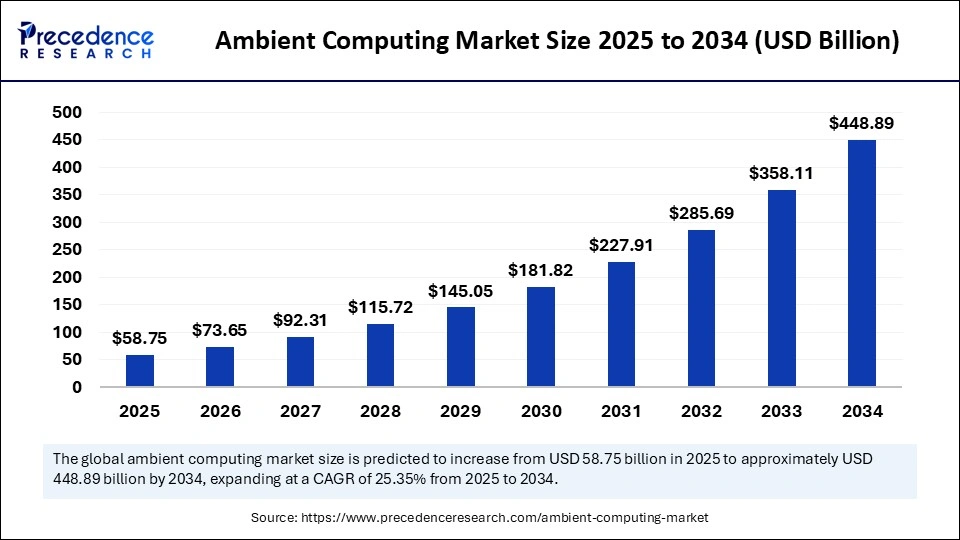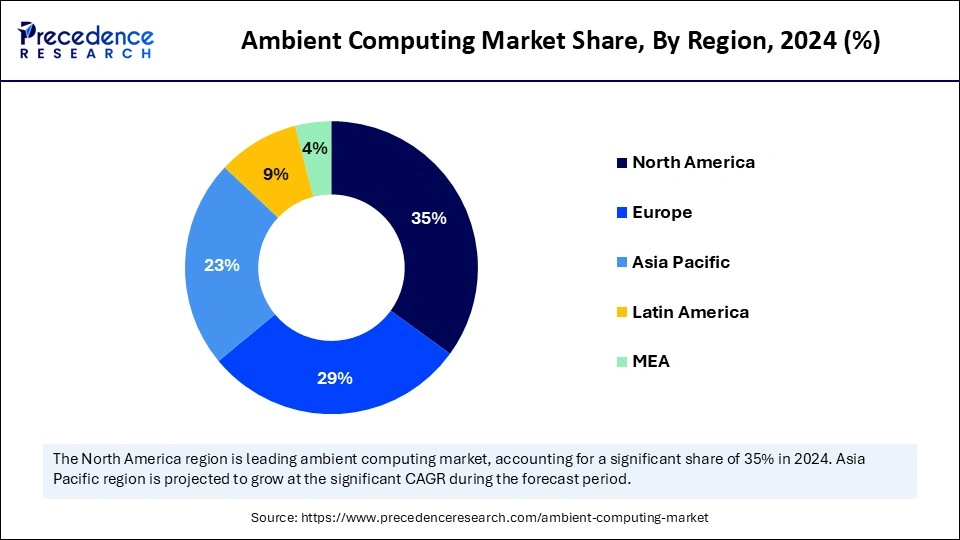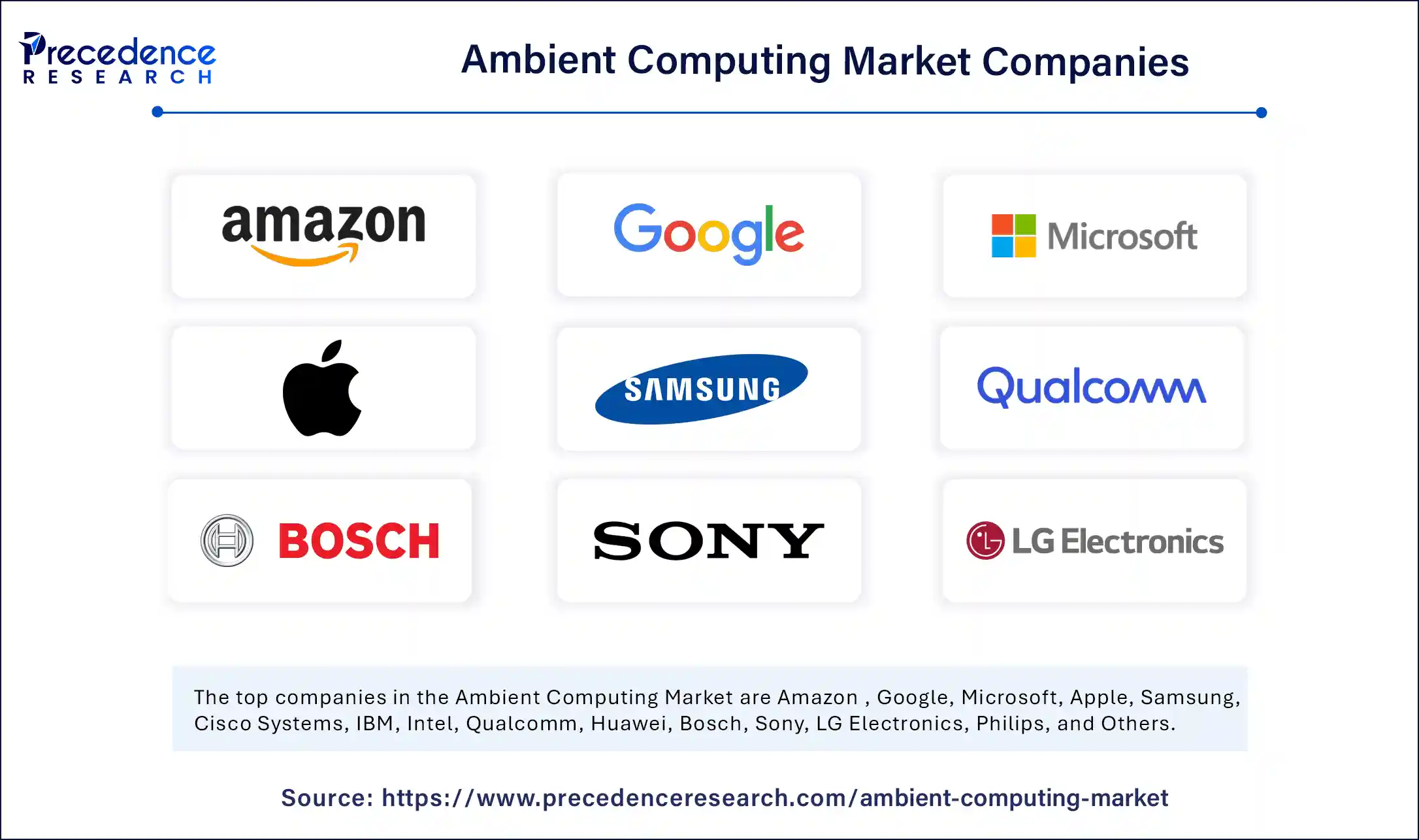List of Contents
Ambient Computing Market Size and Forecast 2025 to 2034
The global ambient computing market size was calculated at USD 46.87 billion in 2024 and is predicted to increase from USD 58.75 billion in 2025 to approximately USD 448.89 billion by 2034, expanding at a CAGR of 25.35% from 2025 to 2034. The increasing preference for smart homes and smart cities by leading nations, government support for smart infrastructure, along the convergence of technologies like IoT, edge computing, and AI are propelling the market's growth on a wider scale.

Ambient Computing Market Key Takeaways
- In terms of revenue, the global ambient computing market was valued at USD 46.87 billion in 2024.
- It is projected to reach USD 448.89 billion by 2034.
- The market is expected to grow at a CAGR of 25.35% from 2025 to 2034.
- North America dominated the ambient computing market with the largest market share of 35% in 2024.
- Asia Pacific is expected to witness the fastest CAGR during the foreseeable period.
- By technology, the IoT segment captured the biggest market share of 40% in 2024.
- By technology, the artificial intelligence (AI) segment is expected to grow rapidly in the coming years.
- By application, the smart homes segment contributed the highest market share of 30% in 2024.
- By application, the healthcare segment is expected to witness the fastest CAGR during the foreseeable period.
- By end user, the consumer electronics segment generated the major market share of 50% in 2024.
- By end user, the healthcare providers segment is expected to witness the fastest CAGR during the foreseeable period.
Market Overview
Ambient computing refers to digital environments where the interaction between human and machine is seamless and continuously integrated into daily life. It involves the use of technologies like IoT, AI, and sensors to create environments that respond to users' needs, with minimal physical input. The market is growing due to increasing demand for smart homes equipped with cutting-edge technologies for better access and safety, smart cities, and personalized solutions across sectors like healthcare, retail, and transportation.
U.S. Ambient Computing Market Size and Growth 2025 to 2034
The U.S. ambient computing market size was exhibited at USD 11.48 billion in 2024 and is projected to be worth around USD 112.35 billion by 2034, growing at a CAGR of 25.62% from 2025 to 2034.

What factors support the growth of the North America ambient computing market?
North America's growth is related to several factors, like increased adoption of smart homes, advanced technological infrastructure, government support for smart cities with technological advancements, widespread adoption of 5G networks, and leading tech giants like Amazon, Apple, and IBM, making the region highly fertile for the expansion of the ambient computing market.
Leading nations like the U.S. and Canada governments are promoting smart city initiatives, further driving the adoption of ambient computing. Also, leading companies like IBM, Intel, and Amazon are heavily investing in developing ambient computing with AI-powered IoT solutions. Moreover, North America has continuously shown interest in adopting various technologies for greater convenience, comfort, and efficiency.

Why is the Asia Pacific ambient computing market expanding globally?
Asia Pacific is expected to witness the fastest CAGR during the foreseeable period of 2025-2034. Governments in the Asia Pacific, especially in countries like Japan and China, are heavily investing in developing smart cities, which include smart street lighting, smart systems to manage and monitor waste, and intelligent systems to manage traffic, which can be achieved by ambient computing technologies. Additionally, the rapid adoption of 5G networks is a key driver of market expansion, offering the necessary high-speed, low-latency, and enhanced connectivity for devices operating within an ambient system.
Rapid urbanization and increasing disposal income have led to high living standards. Also, several start-ups and businesses are leveraging the intelligence of ambient computing to expand their portfolio. A significant investment has been made in the smart transportation network, the establishment of microgrids, and technologically advanced energy management systems.
What Are the Key Trends in the Ambient Computing Market?
- Technological convergence: A significant trend for the expansion of the ambient computing market is the convergence of various technologies to offer a personalized experience. Technologies like AI and ML, IoT devices, 5G & edge computing are some of the leading ones used for various applications. Ambient system requires to learn user behaviors by recognizing natural language and gestures to make real-time adjustments to other services. The integration of various smart sensors and devices works for data collection on user presence to enable the environment‘s response. Also, advancement in 5G and edge computing is critical for seamless connection.
- Shift towards voice input: The growing shift towards more intuitive control by using voice, facial expressions, and gestures as an input instead of manual configuration, same as of virtual assistants, further minimizes user efforts and offers an exact solution easily. By enabling more natural interactions, users can feel comfortable and connected, which increases their usage and satisfaction.
Market Scope
| Report Coverage | Details |
| Market Size by 2034 | USD 448.89 Billion |
| Market Size in 2025 | USD 58.75 Billion |
| Market Size in 2024 | USD 46.87 Billion |
| Market Growth Rate from 2025 to 2034 | CAGR of 25.35% |
| Dominating Region | North America |
| Fastest Growing Region | Asia Pacific |
| Base Year | 2024 |
| Forecast Period | 2025 to 2034 |
| Segments Covered | Technology, Application, End User, and Region |
| Regions Covered | North America, Europe, Asia-Pacific, Latin America, and Middle East & Africa |
Market Dynamics
Drivers
Expanding edge computing
The expansion of edge computing is a major enabler for the sector like ambient computing by offering low-latency, high-reliability, and increased data processing capacity, which are necessary for the ambient environment. Edge computing allows information to be processed at the very source from where it has arisen, and reduces the chances of data loss, with quick processing further offers real-time responses. Also, edge AI allows for monitoring even a smaller change within a space and record signs without the need for constant internet. Edge computing further provides low latency to provide seamless data transmission.
Restraint
Privacy and ethical concerns
Ambient computing offers several benefits, but great power comes with great responsibilities. It has created questions about privacy and ethical considerations as various devices are continuously collecting data. Many times, passively recording every other thing has created a kind of insecurity and loss of privacy, which can blur the line between what is allowed and what should be avoided. Therefore, designers and other technologists should consider ethical frameworks to combat these issues and support transparency, privacy, and the ability to choose specific features and mute other features that are not required.
Opportunity
Highly personalized experience
A significant opportunity that the ambient computing market is witnessing includes a highly personalized experience for users that can be tailored according to their preferences. This can be achieved by using sensors and artificial intelligence, where ambient computing can learn about users' behavior, choices, and provide results and recommendations based on it to align with their demand. This results in a more personalized and highly engaged experience, further enhancing the overall satisfaction of consumers.
Technology Insights
How does IoT help transform the ambient computing market?
The IoT segment held the largest market share of 40% in 2024. IoT devices help to sense physical things and connect with the internet, accordingly, creating the basic environment that supports ambient computing. IoT enables features like task automation, environmental monitoring, and personalized user experience by using data exchange. IoT allows to collect of data about current temperature, motion, speed, and presence of a person, which is highly crucial for systems to be considered as an ambient with responsiveness. Also, key factors of IoT's assertion include its affordability, easy access, automation & efficiency, along with seamless integration and low energy requirement for operation.
The artificial intelligence (AI) segment is likely to expand quickly, particularly the natural language processing (NLP) sub-segment. NLP allows users to interact with technology by using local language without the need for specialized code, transforming the way to use technology in our day-to-day lives. Siri, Alexa, and Google Assistant are some of the prime examples of the application of NLP that allow voice-controlled interactions without any explicit input.
Application Insights
What are the benefits of ambient computing in smart homes?
The smart homes segment held the largest market share of 30% in 2024. Smart home technology provides clear and practical benefits to consumers, such as light controlling with voice input, automatically adjusting thermostats, and monitoring security measures even from a remote distance. The convergence of the Internet of Things (IoT) for device connectivity and the use of AI to learn consumers' behavior and preferences generates a core or base for ambient computing to carry forward the desire system working. Smart homes are specifically designed for residential users, offering solutions for convenience, energy savings, with comfortable living.
The healthcare segment is likely to expand quickly, particularly the wearables for health sub-segment. Segment is expanding due to factors like enhanced efficiency with minimized costs, improved healthcare access, and seamless integration of AI-powered diagnostic tools with the surroundings. Also, telemedicine is essential to bridge the gap between rural and urban healthcare facilities by providing high-quality medical advice and services. Ambient computing solutions support measures in healthcare safety, remote patient care, and help amid public health crises. Many leading players are collaborating to facilitate ambient computing in the healthcare sector.
- In September 2025, the global leader in speech processing solutions announced their partnership with AI infrastructure company Corti to offer ambient clinical documentation for the healthcare sector on the Speech Live Platform.(Source: https://www.theindustrial.in)
End User Insights
Why do consumer electronics dominate the ambient computing market?
The consumer electronics segment held the largest market share due to ongoing developments in the field of AI and deep learning to analyze user data and apply it in real life, which further provides personalized recommendations. Also, consumers like busy professionals opt for the effortless use of technology without the need for explicit commands. Also, consumer electronic devices like smartphone gadgets, smart speakers, smart appliances, and wearable fitness trackers create an existing user base for an ambient computing environment.
The healthcare providers segment is likely to expand quickly, particularly the home health monitoring sub-segment. Ambient computing offers various benefits for healthcare providers by automating administrative tasks, enhancing clinical workflows, which help combat the unnecessary burden of working. By creating a responsive and intelligent environment, ambient computing enables healthcare professionals to focus more on patient-centric work.
Value Chain Analysis
- Assembly and Packaging
This stage encompasses the assembly and manufacturing of core/basic hardware components that make the ambient system work effortlessly. It includes semiconductor chips, microprocessors, and sensors with advanced packaging.
Key players- TSMC, Samsung Electronics, JCET Group, ASE Technology, AMKOR Technology.
- Distribution to OEMs and Integrators
This stage involves manufactured components to move from OEM firms to companies that integrate those parts into expected devices or ambient products to support the whole ecosystem.
Key players- Wipro, Infosys, Advantech, and TCS.
- Lifecycle Support and Recycling
This stage involves addressing potential damage of ambient products after their sales in their entire lifespan to support their maintenance and repairing procedures, which builds trust between consumers and distributors.
Key players- Attero Recycling, RecycleKaro, Delta IT network, ITAD specialists.
Ambient Computing Market Companies

- Amazon
- Microsoft
- Apple
- Samsung
- Cisco Systems
- IBM
- Intel
- Qualcomm
- Huawei
- Bosch
- Sony
- LG Electronics
- Philips
- Honeywell
- Panasonic
- Zebra Technologies
- Nvidia
- Siemens
- Schneider Electric
Recent Developments
- In September 2025, Samsung Electronics will introduce AI home-future living, which is the company's vision at IFA 2025 Berlin during the upcoming period. These products will connect to SmartThings, delivering Samsung's unique AI Home experience that makes life more convenient, efficient, healthy, and safe.
(Source: https://news.samsung.com) - In February 2025, a leading global tech player, HP Inc., declared its target to acquire AI capabilities to facilitate an intelligent ecosystem. The acquisition is expected to accelerate the development of a new generation of devices that integrate AI, improving customer functionality and experience.
(Source: https://www.nasdaq.com)
Segments Covered in the Report
By Technology
- Internet of Things (IoT)
- Smart Home Devices
- Wearables
- Industrial IoT
- Artificial Intelligence (AI)
- Natural Language Processing (NLP)
- Computer Vision
- Machine Learning
- Sensor Technology
- Proximity Sensors
- Motion Sensors
- Environmental Sensors
- Edge Computing
- Cloud-Based Edge Computing
- Localized Edge Computing
By Application
- Smart Homes
- Lighting Control
- Security and Surveillance
- Climate Control
- Healthcare
- Patient Monitoring
- Wearables for Health
- Remote Health Assistance
- Retail
- In-Store Experience Enhancements
- Inventory Management
- Automated Checkout
- Automotive
- Autonomous Vehicles
- In-Car Personal Assistants
- Smart Navigation
- Industrial Automation
- Smart Manufacturing
- Predictive Maintenance
- Supply Chain Automation
- Education
- Smart Classrooms
- Remote Learning Assistance
- Adaptive Learning Platforms
By End User
- Consumer Electronics
- Smart Speakers
- Smart TVs
- Smart Watches
- Healthcare Providers
- Hospitals
- Home Health Monitoring
- Medical Equipment Providers
- Enterprises
- Smart Offices
- Automated Workplaces
- Remote Collaboration Tools
By Region
- North America
- Europe
- Asia Pacific
- Middle East & Africa
- Latin America
For inquiries regarding discounts, bulk purchases, or customization requests, please contact us at sales@precedenceresearch.com
Frequently Asked Questions
Ask For Sample
No cookie-cutter, only authentic analysis – take the 1st step to become a Precedence Research client